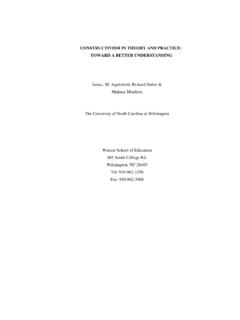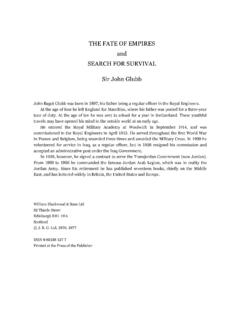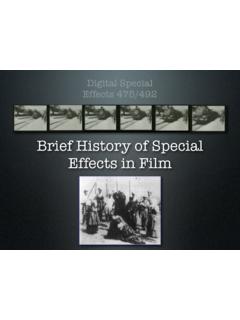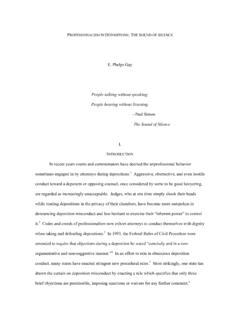Transcription of The Sounds of Silence: Songs In Hollywood Films …
1 Style: Volume 36, No. 1, Spring 200219 Todd Berliner and Philip FuriaUniversity of North Carolina at WilmingtonThe Sounds of Silence: Songs In Hollywood Films Since the 1960sWhen MGM brought out That s Entertainment in 1974, the anthology ofspectacular musical numbers seemed like Hollywood s own eulogy to the end of anera in which song and film were united. The implicit message of That sEntertainment delivered as much by the old film clips as by Fred Astaire, GeneKelly, and the other aging stars who chattily introduced the numbers was thatthey don t film Songs like they used to.
2 The message was essentially accurate: Hollywood no longer makes the type of film musical that flourished between the1930s and the 1950s. Indeed, film critics have often lamented the musical sdemise, as David Thompson did a few years ago in Sight and Sound: Whatever happened to the musical? Is it just that Astaire, Rogers, Kelly, Garland, andCharisse got too old or too dead to do it anymore? Did the astonishing age ofAmerican songwriting just lapse? [..] Did rock and roll crush the musical?
3 Did the genreneed the studio system, rich in chorines, arrangers and choreographers? Was it MTV? Butif it was MTV (at least a derivative of music), why haven t the movies been capable offashioning decent musicals since the late 50s? One moment we were getting Funny Face(1956), Silk Stockings (1957), and Gigi (1957) and then there was nothing. (22)Crippled by economic difficulties, changing film and music styles, and the loss ofthe convention that allowed movies to present Songs as spontaneous expressions ofcharacters feelings, contemporary cinema had to develop new conventions inorder to incorporate musical entertainment into film in fact the kind of musical Thompson describes has died, several filmsof the past forty years use Songs just as imaginatively as did the Films evoked byThat s Entertainment.
4 Nashville (1975), All That Jazz (1979), Yentl (1983), andEveryone Says I Love You (1996), as well as Films we do not ordinarily think of asmusicals, such as The Graduate (1967) and Alice Doesn t Live Here Anymore(1975), have developed new conventions for presenting song in film , conventionsthat build upon traditions established by the classical Hollywood musicals of thestudio era. These new conventions, which we will explore, all in some way respondto the demise of the classical Hollywood musical, especially to the loss of theconvention that characters could burst into song without realistic motivation.
5 Inorder to understand the relation between recent approaches to presenting song andthe history of Songs in movies, we must first briefly survey the ways in which20 Todd Berliner and Philip FuriaHollywood initially developed the conventions for incorporating Songs intonarrative Song in the Classical Hollywood MusicalThe conventions of cinematic realism seemed to preclude the stage practice ofspontaneously breaking into song to express one s feelings. In operettas and stagemusicals, audiences had come to accept such outbursts as conventional, andapplause after a song cushioned the awkward transition back to dialogue.
6 But, inthe late 1920s, film had no comparable conventions to rely upon for bridging theseparation between singing and regular speech. Hence, very early film musicalsnearly always concerned professional singers who sang only when they wereperforming for an on-screen audience, in order to provide a realistic excuse forthe musical numbers. The Jazz Singer (1927) established cinema s song-as-performance convention. Al Jolson sings only when he is performing, rehearsing,or, in the case of the song Blue Skies, demonstrating his talents to his proudmother.
7 His Songs , moreover, do not express his emotions or dramatic situation;they are popular tunes popular even before The Jazz Singer included in the filmmerely so that Jolson can perform them and not to reveal character or advance theplot. In the years after The Jazz Singer, as Richard Barrios details in A Song in theDark: The Birth of Musical Films , Hollywood produced a series of backstagers, such as the 1929 Films On With the Show and Broadway Melody, in whichcharacters sing and dance as they struggle to put on a show.
8 In most of these earlybackstagers, the Songs lyrics bear no relation to story, but in 1933 Warner Brotherslaunched a series of musicals 42nd Street, The Gold Diggers of 1933, andFootlight Parade in which gritty scripts, jazzy Songs by Al Dubin and HarryWarren, and the spectacular choreography of Busby Berkeley all resonate with oneanother. In Gold Diggers of 1935, for example, Ginger Rogers leads chorus girlscostumed as huge coins in a performance of We re in the Money, only to havetheir rehearsal suddenly interrupted by the police.
9 The sheriff repossesses thelavish costumes and closes the show, putting Ginger, Joan Blondell, and the othergirls out of work and out of the money during the backstager has proved one of the most resilient conventions in the historyof the musical because it permitted Songs to be presented as rehearsals, asperformances, and as the effusions of professional singers in love with their gave us radio musicals, such as The Big Broadcast series, that allowedaudiences of the 1930s and 40s to see their favorite radio stars on the screen.
10 InSingin in the Rain (1952) and A Star Is Born (1954), the backstager took us behindthe cameras to show the genesis of film musicals themselves. To this day, thebackstager endures as a vehicle for incorporating Songs into such diverse Films asVictor/Victoria (1982), The Doors (1991), and Moulin Rouge (2001).The convention of spontaneous song where a song emerges not as aperformance for an on-screen audience but as an impulsive emanation of aThe Sounds of silence : Songs In Hollywood Films Since the 1960s21character s feelings developed much more tentatively.



















